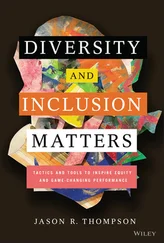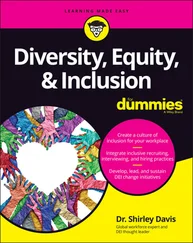Finally, in reviewing responses that employees have provided to GEN's national workplace experience survey, we noted repeated versions of this experience: “Any time we have a training or company meeting about diversity, I am the only Black person in the room. Even if I don't raise my hand, at some point, someone will turn to me and ask me for my opinion—as a Black person—about diversity in our office. What am I supposed to say? I don't speak for all Black people. And I'm not gonna say what I really think.”
The status of being “the only” suddenly becomes synonymous with being “the expert” or “the representative” in conversations about diversity. As this respondent stated, “I don't speak for all Black people.” No race or gender is a monolith. The experiences of one underestimated individual do not necessarily reflect those of other underestimated individuals, and asking one to speak on behalf of a group is an unfair burden. Not only do individuals not want to misrepresent their peers, they do not want to put themselves at risk. Should the one Black person in the room be honest and risk making their white peers defensive and angry? Or, should they perform the emotional labor of comforting their peers with a watered-down version of their experiences as The Black Person in the Workplace?
Trainings create impossible choices for anyone who is “the only” in the room.
Finding Affinity: Employee Resource Groups
For those who are often “the only” in the room, employee resource groups or affinity groups can provide a sense of community and solidarity. While these communities can provide a safe space for people and opportunities for networking, they are also too often treated as a substitute for inclusive workplace cultures. Rather than acknowledge and support the specific role that affinity groups can play, employers often see them as an opportunity to “check” the DEI box and consider the “diversity issue” handled. Providing a siloed space for people to come together over shared identities does not counter the bias they'll continue to face throughout the organization.
These groups also don't guarantee safe spaces for all employees; while organizations may offer women's groups, or groups for people of color, this does not mean that women of color have been offered a safe space. They still face a great deal of risk sharing their experiences with either white women or men of color in spaces where they may once again be “the only.”
While I believe companies should continue to support affinity groups, treating them as a DEI solution is flawed in the same way that encouraging employees to lean in or attend trainings is flawed: It puts the onus on employees to compensate for biased institutions, rather than on the employer to debias them.
≈
“But we've always done it this way…”
I chose this as the title of the chapter because it is the response I hear most often when clients are faced with the shortcomings of the DEI approaches they've been using for years. I understand the inertia that comes with abandoning these approaches. It feels like a risk. But as we'll see in the next chapter, clinging to these methods poses an even bigger risk to the survival of companies that don't evolve.
1 1.The IAT measures the strength of unconscious associations between concepts (e.g., Black people, gay people) and evaluations (e.g., good, bad) or stereotypes (e.g., athletic, clumsy). The main idea is that responding is easier when closely related items share the same response key. “Implicit Association Test (IAT),” Project Implicit, 2011, https://implicit.harvard.edu/implicit/takeatest.html; “About the IAT,” Project Implicit, 2011, https://implicit.harvard.edu/implicit/iatdetails.html.
2 2.“From Love to Voting: Who Really Decides, You or Your Brain?” CBC DOCS, https://www.cbc.ca/natureofthings/features/my-brain-made-me-do-it-who-decides.
3 3.Linnea Dunne, “So You Think You Were Hired on Merit? Gender Quotas and the Perception Gap,” Linnea Dunne (blog), August 21, 2017, http://www.linneadunne.com/2017/08/21/think-hired-merit-gender-quotas-perception-gap/.
4 4.Shari Kendall and Deborah Tannen, “Gender and Language in the Workplace,” ed. Ruth Wodak, Gender and Discourse (1997): 81–105, https://time.com/wp-content/uploads/2017/06/d3375-genderandlanguageintheworkplace.pdf.
5 5.Susan C. Herring, “Gender and Participation in Computer-Mediated Linguistic Discourse” (paper, Annual Meeting of the Linguistic Society of America, Philadelphia, January 9–12, 1992), https://files.eric.ed.gov/fulltext/ED345552.pdf.
6 6.Janet Holmes, “Language Myth # 6: Women Talk Too Much,” PBS, 2005, http://www.pbs.org/speak/speech/prejudice/women/.
7 7.Iris Bohnet, What Works: Gender Equality by Design (Cambridge, MA: Belknap Press, an Imprint of Harvard University Press, 2016), 62–63.
8 8.Benjamin Artz, Amanda H. Goodall, and Andrew J. Oswald, “Do Women Ask?” Industrial Relations: A Journal of Economy and Society 57, no. 4 (2018): 611–636, https://onlinelibrary.wiley.com/doi/abs/10.1111/irel.12214.
9 9.Benjamin Artz, Amanda Goodall, and Andrew J. Oswald, “Research: Women Ask for Raises as Often as Men, but Are Less Likely to Get Them,” Harvard Business Review, June 25, 2018, https://hbr.org/2018/06/research-women-ask-for-raises-as-often-as-men-but-are-less-likely-to-get-them.
10 10.Morela Hernandez and Derek R. Avery, “Getting the Short End of the Stick: Racial Bias in Salary Negotiations,” MIT Sloan Management Review, June 15, 2016, https://sloanreview.mit.edu/article/getting-the-short-end-of-the-stick-racial-bias-in-salary-negotiations/.
11 11.Ashleigh Shelby Rosette, Christy Zhou Koval, Anyi Ma, and Robert Livingston, “Race Matters for Women Leaders: Intersectional Effects on Agentic Deficiencies and Penalties,” The Leadership Quarterly 27, no. 3 (2016): 429–445, https://doi.org/10.1016/j.leaqua.2016.01.008.
12 12.As measured by the percentage of Black women enrolled in college in relation to other race-gender groups. “Black Women Are Ranked the Most Educated Group by Race & Gender,” HBCU Buzz, March 4, 2014, https://hbcubuzz.com/2014/03/black-women-are-ranked-the-most-educated-group-by-race-gender/.
13 13.Zuhairah Washington and Laura Morgan Roberts, “Women of Color Get Less Support at Work. Here's How Managers Can Change That,” Harvard Business Review, March 4, 2019, https://hbr.org/2019/03/women-of-color-get-less-support-at-work-heres-how-managers-can-change-that.
14 14.“The State of Black Women in Corporate America” ( LeanIn.Organd McKinsey & Company, 2020), https://media.sgff.io/sgff_r1eHetbDYb/2020-08-13/1597343917539/Lean_In_-_State_of_Black_Women_in_Corporate_America_Report_1.pdf.
15 15.Daniel A. Effron, Jessica S. Cameron, and Benoît Monin, “Endorsing Obama Licenses Favoring Whites,” Journal of Experimental Social Psychology 45, no. 3 (2009): 590–593, https://doi.org/10.1016/j.jesp.2009.02.001.
16 16.Carol Kulik, Molly Pepper, Loriann Roberson, and Sharon Parker, “The Rich Get Richer: Predicting Participation in Voluntary Diversity Training,” Journal of Organizational Behavior 28, no. 6 (2007): 753–769, https://www.researchgate.net/publication/227677080_The_rich_get_richer_Predicting_participation_in_voluntary_diversity_training.
17 17.Tessa L. Dover, Brenda Major, Cheryl R. Kaiser, “Members of High-Status Groups Are Threatened by Pro-Diversity Organizational Messages,” Journal of Experimental Social Psychology 62 (2016): 58–67, https://doi.org/10.1016/j.jesp.2015.10.006.
18 18.Tessa L. Dover, Brenda Major, and Cheryl R. Kaiser, “Diversity Policies Rarely Make Companies Fairer, and They Feel Threatening to White Men,” Harvard Business Review, January 4, 2016, https://hbr.org/2016/01/diversity-policies-dont-help-women-or-minorities-and-they-make-white-men-feel-threatened.
Читать дальше












